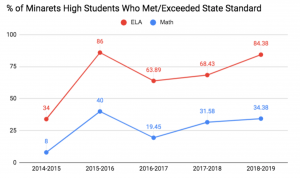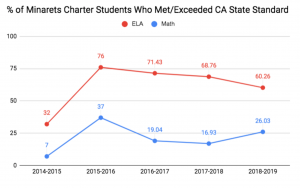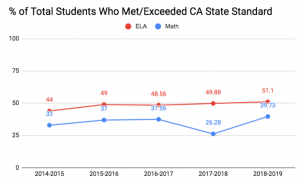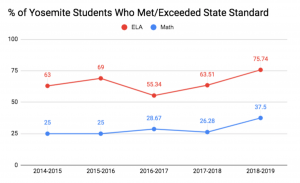Submitted by Johanna Ziegler, student journalist for Minarets Press
O’NEALS – Every year, Minarets juniors, along with high school juniors across the state, sit down to take the California Assessment of Student Performance and Progress test (CAASPP).
The purpose of the CAASPP test is to provide assessment information to schools and families, highlighting which areas in math and English students are excelling in and which areas need to be addressed more in the classroom, according to the California Department of Education.
The CAASPP system was first put in place in 2014 to improve upon the old testing system, the Standardized Testing and Reporting (STAR) Program.
The test itself consists of two assessments, one in English/language arts (ELA) and one in mathematics. While alternate assessments are available in subjects like science, Spanish, and English as a second language, most Minarets juniors take the two traditional tests.
Two years after each junior class takes the test, the Department of Education posts the results on its website, breaking down each school’s results into the following four categories for each assessment: Standard Exceeded, Standard Met, Standard Nearly Met, and Standard Not Met.
Traditionally, the Department of Education combines the top two categories into a fifth category, Standard Met or Exceeded. It is this category that bears the most weight to administrators, teachers, and parents.
It paints the most accurate picture of how well students are grasping math and English concepts that the Department of Education deems necessary or ‘standard.’
But just how well have Minarets juniors been scoring?
The data for Minarets High and Minarets Charter begins in 2014, with the most recent results coming in from the 2018-2019 junior class.
 As seen in the two graphs to the left, the trendlines of the two high schools under the Minarets umbrella follow a similar pattern.
As seen in the two graphs to the left, the trendlines of the two high schools under the Minarets umbrella follow a similar pattern.
Scores saw a massive surge from 2014-2015 to 2015-2016, scores in both ELA and math more than doubling.
While 2016-2017 scores took somewhat of a hit, the percentage of students meeting or exceeding the state standard has been increasing, for the most part, every year since.
 Upper-class English teacher Michael Vaughan, who joined the Minarets staff in 2014, believes the rise in ELA scores has to do with the curriculum.
Upper-class English teacher Michael Vaughan, who joined the Minarets staff in 2014, believes the rise in ELA scores has to do with the curriculum.
“Reading and writing across the curriculum play a major role,” Vaughan explained. “Simplifying the research and essay writing process helps many students with organization and synthesizing. Practice helps as well.”
Upper-class math teacher Ryan Hansen, who’s been with Minarets since its beginning, also nodded towards curriculum.
“More and more teachers are being trained on how to implement STEM [Science, Technology, Engineering, and Mathematics] education in their classrooms. I believe with the focus that has been put on STEM education, students are starting to see the importance of learning mathematics.”
Hansen also prefers to incorporate data education into his classroom.
“In math class, the techniques I like to use involves using spreadsheets to teach math. Excel and Google Sheets are very powerful tools that all students should learn how to use,” he said. “In today’s world, everything is driven by data.”
While the regular high school and charter high school scores demonstrate a similar pattern, there are still some noticeable differences.
For example, charter students tend to score lower than regular high school students in both assessments, even if the separation is only by a few percentage points.
Additionally, since 2016, the charter ELA scores have been slowly trending downward, while the regular high school ELA scores have been shooting up, reaching 84.38% meeting or exceeding in 2018-2019 while the charter rate was only at 60.26% that same year.
Vaughan believes “student buy-in to the test” may be a factor in these discrepancies. Students disinterested in the test may not work as hard to score well, creating an inaccurate representation of their true intelligence and grasp of the concepts.
Underclass English teacher Kayla West, who also joined Minarets in 2014, answered similarly to the gaps. “There seems to be an ebb and flow. Some years we have a really driven class, and then the next the whole group is not a motivated bunch.”
Hansen did point out the score differences could stem from the quality of education leading up to high school. While most students enrolled in the regular high school tend to come from the same few elementary and middle schools, charter students’ previous schools are more scattered, creating variations that can work both for and against them.
Even with these concerns, Minarets still tends to score higher than the statewide meet/exceed rates.
 For the past five years, the statewide ELA meet/exceed rates have tended to hover around 40-50% while Minarets (both regular and charter) have been scoring in the 60-80% zone. While Minarets tends to share similar scores in the math assessment, both in 2015-2016 and 2017-2018, the regular Minarets students scored higher than the state average.
For the past five years, the statewide ELA meet/exceed rates have tended to hover around 40-50% while Minarets (both regular and charter) have been scoring in the 60-80% zone. While Minarets tends to share similar scores in the math assessment, both in 2015-2016 and 2017-2018, the regular Minarets students scored higher than the state average.
Minarets holds up well enough when compared to the state averages, but how does it compare to other schools in the area?
 Its nearby rival Yosemite High School (YHS), only a hundred or so students larger, has been competing with Minarets for incoming students from the Coarsegold/Yosemite Lakes Park area for years, and test scores may be a tool in deciding which school to attend. While YHS has been in operation much longer than Minarets, which may account for the major difference in scores in 2014-2015, more often than not, Minarets reports higher numbers.
Its nearby rival Yosemite High School (YHS), only a hundred or so students larger, has been competing with Minarets for incoming students from the Coarsegold/Yosemite Lakes Park area for years, and test scores may be a tool in deciding which school to attend. While YHS has been in operation much longer than Minarets, which may account for the major difference in scores in 2014-2015, more often than not, Minarets reports higher numbers.
Since 2015, Minarets has been testing better in ELA. In math, the two schools fluctuate back and forth, both tending to report roughly the same percentages of meet/exceeds.
Families on the fence looking for the best education are statistically more likely to find it at Minarets in the English Department and will see roughly the same math education regardless of school.
“Over the last few years, Minarets has really begun to focus on different strategies to meet the needs of our students,” said West. “We began an Intervention program for students who were struggling, we have also provided more opportunities for dual enrollment, or AP classes, which encourages our highly motivated students, as well. So I have seen a definite effort to really try and zero in on specific groups and their needs, versus just leaving it up to the individual teacher to reach out.”
Is Minarets heading the right way in test scores? The short answer is yes. Both regular high school and charter juniors are mostly keeping up with math standards and are continually exceeding ELA standards.
On a local level, Minarets is keeping pace with nearby high schools and in many instances, outperforming them. While there is always room for improvement, the Minarets CAASPP scores are moving in the right direction, and the next batch of results set to be released in a year or so are likely to confirm this.
Sources:
CAASPP Breakdown
Program Overview
CAASPP Scores
Read the original story on Minarets Press: https://minaretspress4.wixsite.com/minaretspress/post/is-minarets-heading-the-right-way-in-test-scores




